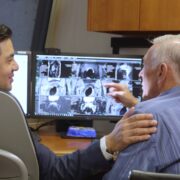
An estimated 191,930 cases of prostate cancer will be diagnosed in 2020, according to Filipino American Dr. Edwin Posadas of Cedars-Sinai Medical Center in Los Angeles.
This type of cancer occurs in the prostate, a gland in the male reproductive system that produces the seminal fluid that nourishes and transports sperm. It is the most common cancer that affects men, and the second leading cause of cancer death, following lung cancer.
In the “2020 WHO Report on Cancer” of the World Health Organization (WHO), it stated that there were 1.3 million cases of prostate cancer in 2018, of which 7,290 were diagnosed in the Philippines.
According to Posadas, prostate cancer is becoming a more serious problem in the country. Filipino men are developing prostate cancer at rates disproportionate to other Asian men.
“As the lifestyles of the Filipinos become more and more western, the rates of prostate cancer increase. This has a lot to do with lifestyle, exercise, and so on and so forth,” Posadas, medical director of the Urologic Oncology Program of the Samuel Oschin Comprehensive Cancer Institute at the medical center, said during a virtual forum on Thursday, October 8.
“The problem is not being recognized back at home. It’s not a problem that Filipino doctors know how to deal with effectively,” he added.
Posadas noted that the United States, on the other hand, is making progress in the area of prostate cancer.
Based on the American Cancer Society’s statistics, the prostate cancer death rate has declined by 52%, from a peak of 39.3 (per 100,000) in 1993 to a low of 18.8 in 2017.
The rapid reduction in prostate cancer mortality is attributed to earlier detection and advances in treatment.
Symptoms and treatment
Prostate cancer is an important problem for all men. One in nine men will usually be diagnosed with it in their lifetime.
Increasing age, African ancestry, family history of prostate cancer, and certain inherited genetic conditions like Lynch syndrome, BRCA1 and BRCA2 mutations are the primary factors of the disease. Smoking also increases the risk of fatal prostate cancer, while having excess body weight increases the risk of aggressive and fatal prostate cancer.
“The scary thing about prostate cancer is that most prostate cancers have no symptoms,” Posadas said.
Symptoms that may be related to prostate cancer include difficulties with urinating, blood in the urine or semen, erectile dysfunction (ED), pain in areas in the body from cancer that has spread to the bones, weakness or numbness in the legs or feet, or even loss of bladder or bowel control from cancer pressing on the spinal cord.
“You can have these symptoms but that happens on a very rare number of occasions,” Posadas pointed out.
“Majority are found on what we call ‘cancer screening,’” he added.
There are two kinds of cancer screening for prostate cancer: a blood test for prostate-specific antigen (PSA), a protein produced by both cancerous and noncancerous tissue in the prostate, and rectal examination.
Posadas revealed that men with prostate cancer don’t always need to be treated immediately.
“Just because you have cancer doesn’t mean you need to go and have something done about it. But you should know so you can make a decision about what to do,” he said.
If the cancer is not aggressive, a patient may be suitable for active surveillance, which is a series of close monitoring of prostate cancer in partnership with a doctor, regular examinations and PSA assessments, and periodic biopsies.
The two other treatment options for prostate cancer are robotic prostatectomy, which is the surgical removal of the prostate using a robotic system, and radiation therapy.
While there is still no cure for prostate cancer, there are ways to prevent getting the disease.
Among these are: getting to and staying at a healthy weight; keeping physically active; and following a healthy eating pattern which includes a variety of colorful fruits and vegetables and whole grains. Men should also avoid or limit consuming red and processed meats, sugar-sweetened beverages, and highly processed food.
Taboo topic
“When found early, prostate cancer can be very effectively managed,” Posadas noted.
However, most men would rather avoid talking about prostate cancer. In the Philippines, the rate of men who have undergone a screening test for the disease is only at 6.5 percent.
Posadas attributed this low percentage to the feelings of shame and fear.
“(There is) the fear of having to get treated for prostate cancer. There are many perceptions from folks of all cultures that if you have prostate cancer and you need treatment, that it’s going to ruin your sexual health and urinary health,” he said.
While not every prostate cancer results in death, Posadas stressed that undetected prostate cancer can lead to many problems in the future.
“If you do nothing about prostate cancer, a man would still probably live more than a decade with the cancer growing and spreading,” he said.
“The problem with that is, as the time progresses and the cancer gets to different organs like the bones, the liver, the lungs, and it starts to impact organ function, that would mean things like lower blood count, fractures, weight loss, liver dysfunction, and pain. And eventually, weakness to the point where the body shuts down, either because all the nutritions have been zapped out, or the bone marrow no longer works enough to supply enough oxygen to the body,” he added.
Posadas insisted that awareness is key to preventing prostate cancer.
“There is a concerning lack of awareness of this problem in our community. I’m hoping that the folks here…will at least help us to create some awareness,” he said.
He added, “Together we can make more people aware of this problem, and do something about it, and change those statistics because by educating each other and supporting one another, we can impact great changes in our community and those around us. (Ritchel Mendiola / AJPress)




